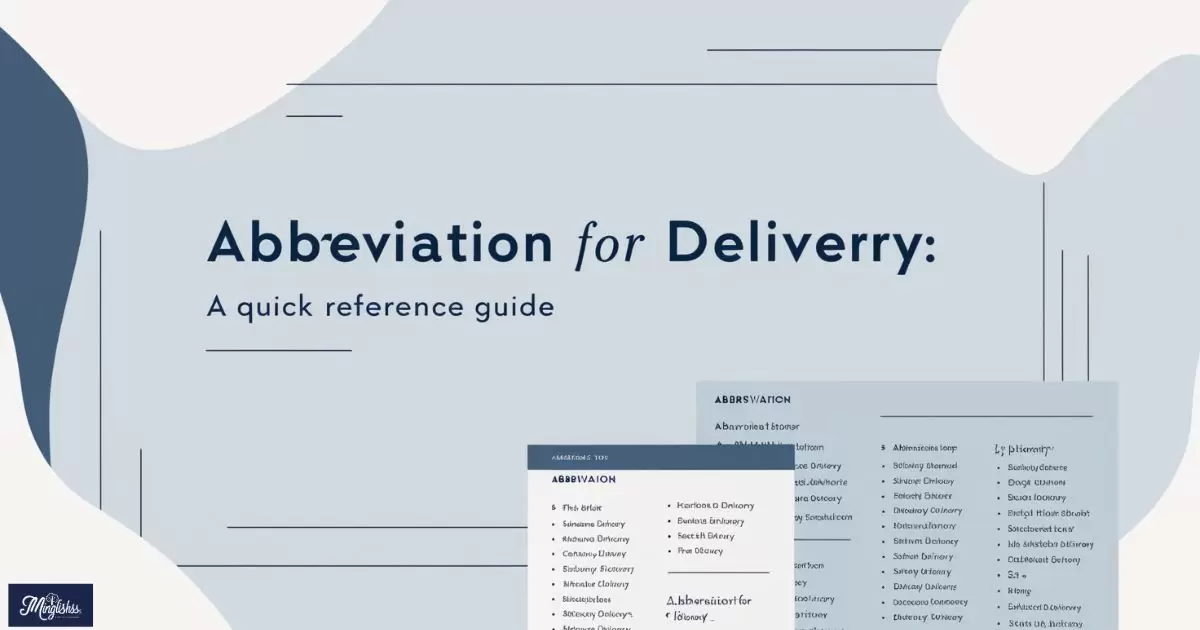Introduction
In the fast-paced world of logistics and shipping, abbreviations for “delivery” are essential for efficient communication and operation. These abbreviations help streamline processes, reduce errors, and speed up decision-making.
Whether you’re coordinating shipments, tracking packages, or managing logistics, understanding these abbreviations can greatly enhance your efficiency.
Looking to optimize your delivery management? Familiarize yourself with the key abbreviations related to delivery to simplify your workflow and improve communication. This guide will provide you with a quick reference to the most commonly used delivery abbreviations, helping you navigate your responsibilities with ease.
In the logistics industry, abbreviations for “delivery” are more than just shortcuts; they are vital for clear and concise communication. By mastering these abbreviations, you can better manage deliveries, avoid confusion, and ensure smooth operations. This guide will explore common abbreviations used in delivery contexts and their practical applications.
Common Abbreviations for Delivery
Here are some key abbreviations related to delivery that you should be familiar with:
DEL
“DEL” stands for Delivery. This abbreviation is widely used in logistics and shipping to indicate that a package or shipment has been delivered. For example, a status update might show “DEL” to signal that the delivery process is complete.
DLV
“DLV” is another common abbreviation for Delivery. It’s often used in formal shipping documents or tracking systems to denote the delivery status. For instance, a shipping report might list “DLV” to confirm that the item has reached its destination.
DELV

“DELV” stands for Delivered. This abbreviation confirms that a package or order has been successfully delivered. It’s commonly used in tracking notifications and delivery confirmations to provide a clear update on the delivery status.
D
“D” can be used as a shorthand for Delivery in informal contexts or internal notes. For example, a quick note might use “D” to indicate a completed delivery task.
D/O
“D/O” stands for Delivery Order. This term refers to a document that authorizes the release of goods for delivery. It’s a crucial part of the delivery process, ensuring that the correct items are handed over to the right party.
Why Use Abbreviations?
Why are delivery abbreviations important? Here’s why:
- Efficiency: Abbreviations simplify and speed up communication, making the delivery process more efficient.
- Clarity: Using standardized abbreviations helps ensure that delivery statuses are clear and easily understood.
- Space-Saving: Abbreviations save space in documents and tracking systems, making them more concise and user-friendly.
Use in Example Sentences
Full
- The delivery of your order was completed yesterday.
- According to the tracking system, the delivery is scheduled for tomorrow.
- Please verify the delivery address before dispatching the package.
- The system needs to be updated to reflect the delivery status.
- The delivery order has been processed and is ready for pickup.
Abbreviation
- The DEL of your order was completed yesterday.
- According to the tracking system, the DLV is scheduled for tomorrow.
- Please verify the D/O address before dispatching the package.
- The system needs to be updated to reflect the DELV status.
- The D/O has been processed and is ready for pickup.
Grammar Coach: Mastering the Present Indefinite Tense
Answer to Key Question About Delivery
How do I choose the right abbreviation for delivery-related communication?
Select the abbreviation based on the context and formality of your communication. For formal documents and tracking systems, use “DELV” or “DLV.” For informal notes or internal use, “DEL” or “D” might be appropriate.
Are there any other common abbreviations related to delivery?
Yes, other related abbreviations include “ETA” for Estimated Time of Arrival, “FOB” for Free on Board, and “COD” for Cash on Delivery. Knowing these can further improve your delivery management.
Can abbreviations for delivery be used interchangeably?
Abbreviations can be used interchangeably in some contexts, but clarity is crucial. Ensure that the abbreviation you choose is understood by your audience to avoid confusion.
How can abbreviations improve my delivery management?
Abbreviations streamline communication, making it faster and more efficient. They help in tracking delivery statuses and managing logistics effectively.
What if I encounter an unfamiliar abbreviation in delivery documentation?
Consult a reference guide or ask a colleague for clarification. Understanding each abbreviation will help you manage deliveries more effectively and avoid potential issues.
Are delivery abbreviations the same across different industries?
Abbreviations may vary slightly depending on the industry and region. Familiarize yourself with industry-specific abbreviations to ensure accurate communication.
Conclusion
Mastering abbreviations for delivery is essential for efficient and effective communication in logistics and shipping.
By understanding and using these abbreviations correctly, you can streamline your delivery processes, reduce misunderstandings, and improve overall productivity. Embrace these shortcuts to enhance your delivery management and ensure smooth operations.

I’m Jane Austen, a language expert at Minglishs, dedicated to helping learners master English through engaging and accessible content. My passion for literature and teaching drives me to make language learning both enjoyable and effective.










